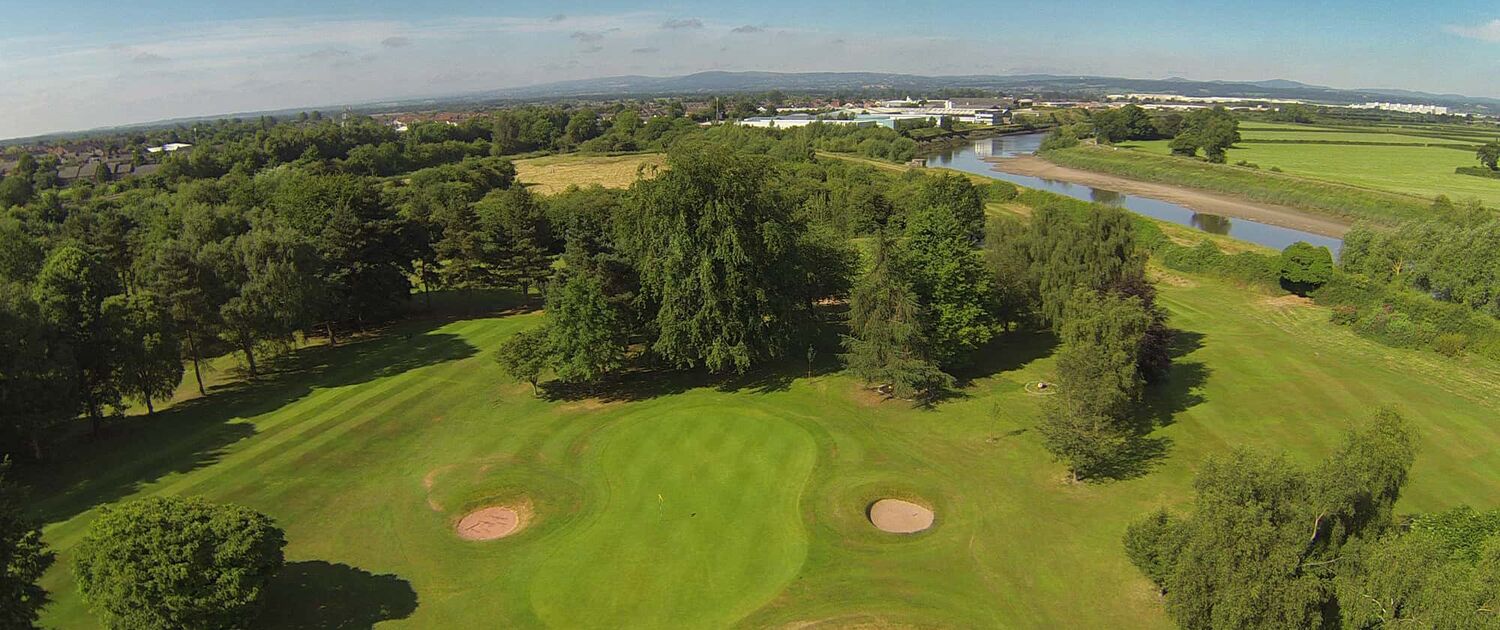STANDING LOCAL RULES:
1. Where under these, or an event specific Local Rule, play is prohibited from any area, or condition; the player must take relief under the applicable Rule.
2. Out of Bounds (Rule 14)
A ball is out of bounds when all of it lies in, on, or beyond a boundary of the course defined by a white marker line, a trench or by a line projected at ground level between the "inner course side" of consecutive white stakes. Where both a line or trench and stakes occur at a boundary, the line or trench defines the out of bounds, the stakes are used to indicate the presence of the out of bounds. Where a trench and a white line occurs, the line defines the out of bounds. Otherwise a ball is out of bounds when all of the ball lies beyond a boundary or on any area defined as follows:
a.) Where a fence forms a course boundary and when the supporting posts protrude from the fence (not struts angled onto the course), a line projected at ground level between the nearest "inner course side" of the posts defines the boundary. Otherwise a ball is out of bounds when it lies beyond any boundary fence or wall. Any netting or similar material directly attached to a boundary fence is deemed to be part of that fence.
b.) Where a hedge forms a boundary of the course, the out of bounds shall be determined by an imaginary plane projected vertically from a line at ground level following the centreline of the hedge plantline.
c.) Except where denoted in any event specific Local Rule, a ball lying on or beyond any pathway, drive or surfaced car park area surrounding the Clubhouse is out of bounds.
d.) Except where denoted in any event specific Local Rule, a ball lying on any practice putting green or practice area which is otherwise within the marked boundaries of the course is out of bounds. Any such putting or pitching green on which practice is permitted before or between rounds shall be a "Wrong Green" during the "Stipulated Round".
3. Penalty Areas (Rule 17.)
3.1 Penalty Areas are defined by yellow stakes or lines. Lateral Relief Penalty Areas are defined by red stakes or lines. Where both stakes and lines occur, the line defines the boundary, stakes indicate the presence of the hazard. Except where denoted in any event specific Local Rule stakes defining or indicating a water hazard are obstructions and may be moved but only when it can be done without unreasonable effort, delaying play or causing damage.
3.2 Where the margin of a Penalty Area is not clearly specified by a line or posts, the general break of the ground will be taken as the boundary. All bridges and crossings within the general line of a Penalty Area are deemed to lie within the margin of the Penalty Area unless defined otherwise in an event specific Local Rule.
4. Abnormal Ground Conditions (Rule 16)
The following are considered to be areas of "Abnormal ground Conditions", relief from these conditions may be obtained under Rule 16.1.
a.) Any area encircled by a white or blue line, defined by posts or denoted by a specific notice.
b.) "Cultivated" heather and or flower beds within the boundaries of the course. New tree or bush plantations when the entire area is bounded by indicating lines or stakes. Play is prohibited from all these areas, or where the player's stance or area of intended swing is affected . Rule 16.1f
c.) Vehicle/tractor wheel ruts, but only where there is specific indentation of the underlying area of ground; disturbance or compression of the surrounding grass or vegetation alone does not warrant relief without penalty under this Rule.
d.) Any area of damaged ground that is considered by a Rules Official to be abnormal.
5. Obstructions (Rule 16.)
The following features are clarified as being "Immoveable Obstructions", relief may be obtained under Rule 16.1.
a.) Individual staked trees, young trees having protective sleeves and other trees or shrubs indicated by a form of marking specified in any event specific Local Rule. Play is prohibited from any position close to such a feature where interference with the player's stance or area of swing occurs. Rule 16.1f
b.) All "artificially surfaced" paths, roadways, standings and "constructions" on the course except where a feature has been declared an integral part of the course under any event specific Local Rule.
c.) Where a white lined area adjoins an Immoveable Obstruction, it is considered to be "tied in" and part of the obstruction, not a separate condition.
d.) Stone filled, drainage ditches or channels not otherwise marked as Penalty Areas.
e.) In addition to the relief available from an Immoveable Obstruction close to a Putting Green under Rule 16.1. If a ball lies off the Putting Green but not in a hazard, and an Immoveable Obstruction on or within two club-lengths of the putting green and within two club-lengths of the ball, intervenes on the line of play to the hole; the player may take relief as follows:
The ball must be lifted and dropped at the nearest point to where the ball lay that i.) is not nearer the hole, ii.) avoids interference and iii.) is not in a hazard or on a Putting Green. The ball may be cleaned when lifted. Relief is also available under this Local Rule if the player's ball lies on a Putting Green and an Immoveable Obstruction within two club-lengths of the Putting Green intervenes on his line of putt. The player should proceed as above but the ball must be placed. The ball must be placed at the nearest point as defined but this may be on the Putting Green.
f.) Logs to the rear of 2nd Green
The logs to the rear of the 2nd green are to be treated as an immovable obstruction. If a player's ball in the general area comes to rest against the logs, or the logs interfere with a player's swing, then the player may take free relief by dropping the original ball or another ball in this relief area (see Rule 14.3):
Reference Point: The nearest point of complete relief in the general area.
Size of Relief Area Measured from Reference Point: One club-length, but with these limits:
Limits on Location of Relief Area:
Must be in the general area,
Must not be nearer the hole than the reference point, and
There must be complete relief from all interference by the immovable object.
Note that the out of bounds in this area of the golf course is the fence that runs behind the logs.
6. Practice (Rule 7-1.)
In Strokeplay, the provisions of Rule 7-1 apply. Where an area within the boundaries of the course is defined as a recognized practice area under an event specific Local Rule, the area may be used by players for practice on any day of a competition.
7. Limitation of Relief:
A player may not obtain relief under the provision of these or any event specific Local Rules if it is clearly unreasonable for a stroke to be played because of interference by anything other than the condition covered by the applicable Local Rule, or if such interference would only occur through the use of an unnecessarily abnormal stance, swing or direction of play.
GENERAL PENALTY FOR BREACH OF A LOCAL RULE: (WHERE NOT SPECIFIED UNDER THE RULES OF GOLF)
MATCHPLAY - LOSS OF HOLE; STROKEPLAY - TWO STROKES.
Chester Golf Club Golf Committee - May 2024







